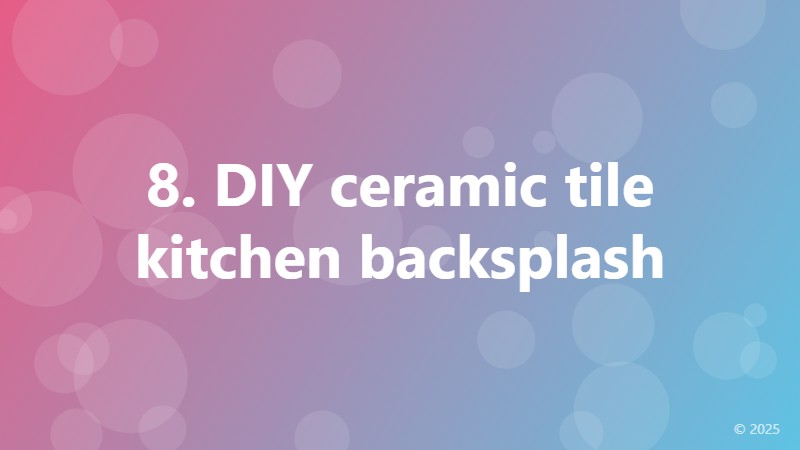8. DIY ceramic tile kitchen backsplash

Why DIY Ceramic Tile Kitchen Backsplash is a Great Idea
When it comes to kitchen renovation, one of the most important decisions homeowners face is choosing the right backsplash material. While there are many options available, DIY ceramic tile kitchen backsplash has become a popular choice among homeowners in recent years. Not only is it aesthetically pleasing, but it's also easy to install and maintain. In this article, we'll explore the benefits of DIY ceramic tile kitchen backsplash and provide a step-by-step guide on how to get started.
Benefits of DIY Ceramic Tile Kitchen Backsplash
One of the main advantages of DIY ceramic tile kitchen backsplash is its cost-effectiveness. Compared to hiring a professional, doing it yourself can save you a significant amount of money. Additionally, ceramic tiles are durable and easy to clean, making them a practical choice for busy homeowners. They're also resistant to heat, moisture, and scratches, ensuring that your backsplash remains looking great for years to come.
Another benefit of DIY ceramic tile kitchen backsplash is the flexibility it offers in terms of design. With a wide range of tile styles, colors, and patterns available, you can create a unique look that reflects your personal taste and style. Whether you prefer a modern, sleek design or a more traditional look, ceramic tiles can help you achieve the desired aesthetic.
Materials Needed for DIY Ceramic Tile Kitchen Backsplash
Before you start your DIY ceramic tile kitchen backsplash project, make sure you have the following materials:
- Ceramic tiles of your choice
- Tile adhesive
- Grout
- Grout sealer
- Tile cutter or tile nippers
- Notched trowel
- Rubber grout float
- Sponge
- Measuring tape
- Pencil and marker
Step-by-Step Guide to DIY Ceramic Tile Kitchen Backsplash
Now that you have all the necessary materials, it's time to start your DIY ceramic tile kitchen backsplash project. Here's a step-by-step guide to help you get started:
Step 1: Prepare the Area - Before you start installing the tiles, make sure the area is clean, dry, and free of old adhesive or grout. Remove any outlet covers and switch plates, and cover the countertops and floors with drop cloths.
Step 2: Measure and Mark the Area - Measure the area where you'll be installing the tiles, and mark it with a pencil. Use a level to ensure that the marks are straight and even.
Step 3: Apply Tile Adhesive - Apply the tile adhesive to the marked area, using a notched trowel to spread it evenly. Hold the trowel at a 45-degree angle to ensure proper coverage.
Step 4: Install the Tiles - Begin installing the tiles, starting from the center and working your way outward. Use a level to ensure that the tiles are straight, and a rubber mallet to tap them into place.
Step 5: Grout the Tiles - Once the tiles are installed, let the adhesive dry completely. Then, mix the grout according to the manufacturer's instructions, and apply it to the tiles using a rubber grout float. Wipe away any excess grout with a sponge.
Step 6: Seal the Grout - After the grout has dried, apply a grout sealer to protect it from stains and water damage.
And that's it! With these simple steps, you can create a beautiful and functional DIY ceramic tile kitchen backsplash that will enhance the look and feel of your kitchen.